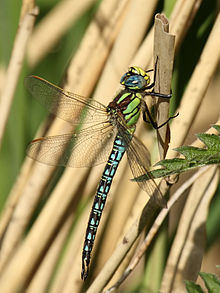Formerly reed hunters
| Formerly reed hunters | ||||||||||||
|---|---|---|---|---|---|---|---|---|---|---|---|---|

Early reed hunter ( Brachytron pratense ) |
||||||||||||
| Systematics | ||||||||||||
|
||||||||||||
| Scientific name | ||||||||||||
| Brachytron pratense | ||||||||||||
| ( OV Müller , 1764) |
The Early reed Hunter ( Brachytron pratense ) is a dragonfly from the family of aeshnidae (Aeshnidae) which the subordination of the dragonfly belong (Anisoptera). It is a medium-sized dragonfly species with a maximum wingspan of eight centimeters. In older literature this species often still has the German name Kleine Mosaikjungfer .
features
The early reed hunter reaches wingspans of seven to eight centimeters and a total length of almost six centimeters. The chest section ( thorax ) of the robustly built animals is greenish-yellow with black markings, the abdomen ( abdomen ) black with a blue markings in the males and a yellow-green in the females. The hairiness of the thorax and the anterior abdominal segments is noticeable, which is why the species is also known as "Hairy Dragonfly" in English. There is a particular risk of confusion with the autumn mosaic maiden ( Aeshna mixta ), which has only two yellow-green stripes on the sides of the thorax and whose flight time is practically completely separated from that of the early reed hunter.
distribution
The area of the early reed hunter is largely limited to Europe, the closed distribution area mainly includes Central and Eastern Europe. In the west, the species reaches the Atlantic in Portugal, but the west and south European populations are quite isolated and often to be considered isolated. In the north Ireland, England, Denmark, southern Sweden and southern Finland are reached. The vertical distribution in Central Europe is mainly limited to the plains, in the Balkans, however, suitable bodies of water are also populated on plateaus in middle mountain areas and even locations up to 1400 m are reached.
Way of life
The early reed hunter is one of the first dragonflies to appear in spring. The emergence period can start as early as the end of April in Central Europe, and even as early as the end of March in Southern Europe. The flight time of the early reed hunter is accordingly between May and July. During this time the species can be found in stagnant and slowly flowing waters, whereby the males usually fly through tall belts of aquatic plants at a low height above the water level and sit there on the plants. The pairing is initiated in flight and also takes place here or on the ground. To lay eggs, the female, unaccompanied by the male, sits horizontally on softened, floating or rotten parts of the plant, into which she pricks the eggs; living plant material is used very rarely. The developing waters of the species often have a pronounced, sunny shallow water zone, which is mostly covered with reed beds (especially reeds and cane grass). The early reed hunter is one of the few dragonfly species that can develop in brackish water.
Larval development
The larvae live in the vegetation of the water, like in root systems and submerged branched plants, whereby they like to nestle close to elongated structures. They usually take three years to develop. When harassed, the larvae pretend to be dead.
Others
In addition to the scientifically valid name Brachytron pratense , the name B. hafniense is also very often used for this species. Both names were given at the same time in the same publication by OF Müller in 1764 , when the male was described as Libellula pratensis and the female as Libellula hafniensis . In such cases, according to ICZN Code Article 24.2.2, the first revising author decides which of the two names must be used.
Individual evidence
- ↑ Pages 61 and 62 in Müller, OF 1764. Favna insectorvm Fridrichsdalina, sive methodica descriptio insectorvm agri Fridrichsdalensis, cvm characteribvs genericis et specificis, nominibvs trivialibvs, locis natalibvs, iconibvs allegatis, novisqve specibvribs add. - pp. I-XXIV [= 1-24], 1-96. Hafniae, Lipsiae. (Gleditsch).
literature
- H. Bellmann: Observe dragonflies - determine. Naturbuch Verlag, Augsburg, 1993, ISBN 3-89440-107-9 .
- G. Jurzitza: The Kosmos dragonfly guide . Franckh-Kosmos Verlag, Stuttgart 2000, ISBN 3-440-08402-7 .
- P. Münchberg: On the biology of the Odonatengenera Brachytron Evans and Aeschna Fbr. In: Journal for morphology and ecology of animals. 20 (1), 1930, pp. 172-232.
- G. Peters: The noble dragonflies of Europe (Aeshnidae). (= Die Neue Brehm-Bücherei. Volume 585). Ziemsen, Lutherstadt Wittenberg 1987, ISBN 3-7403-0050-7 .
- K. Westermann: Hatch abundance and hatch habitat of the early reed hunter ( Brachytron pratense ) in the nature reserve "Rheinniederung Wyhl-Weisweil". In: Nature conservation on the southern Upper Rhine. 4 (1), 2003, pp. 99-112.
- K. Sternberg, B. Höppner: Brachytron pratense (Müller, 1764) - Formerly reed hunter. In: K. Sternberg, R. Buchwald (Ed.): Die Libellen Baden-Württemberg. Volume 2: Dragonflies (Anisoptera). Ulmer, Stuttgart 2000, ISBN 3-8001-3514-0 , pp. 148-157.


